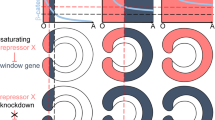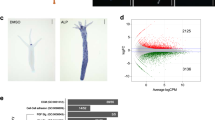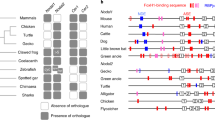Abstract
In bilaterians, three orthogonal body axes define the animal form, with distinct anterior–posterior, dorsal–ventral and left–right asymmetries. The key signalling factors are Wnt family proteins for the anterior–posterior axis, Bmp family proteins for the dorsal–ventral axis and Nodal for the left–right axis1. Cnidarians, the sister group to bilaterians, are characterized by one oral–aboral body axis, which exhibits a distinct biradiality of unknown molecular nature. Here we analysed the biradial growth pattern in the radially symmetrical cnidarian polyp Hydra, and we report evidence of Nodal in a pre-bilaterian clade. We identified a Nodal-related gene (Ndr) in Hydra magnipapillata, and this gene is essential for setting up an axial asymmetry along the main body axis. This asymmetry defines a lateral signalling centre, inducing a new body axis of a budding polyp orthogonal to the mother polyp’s axis. Ndr is expressed exclusively in the lateral bud anlage and induces Pitx, which encodes an evolutionarily conserved transcription factor that functions downstream of Nodal. Reminiscent of its function in vertebrates2,3, Nodal acts downstream of β-Catenin signalling. Our data support an evolutionary scenario in which a ‘core-signalling cassette’ consisting of β-Catenin, Nodal and Pitx pre-dated the cnidarian–bilaterian split. We presume that this cassette was co-opted for various modes of axial patterning: for example, for lateral branching in cnidarians and left–right patterning in bilaterians.
This is a preview of subscription content, access via your institution
Access options
Subscribe to this journal
Receive 51 print issues and online access
$199.00 per year
only $3.90 per issue
Buy this article
- Purchase on Springer Link
- Instant access to full article PDF
Prices may be subject to local taxes which are calculated during checkout





Similar content being viewed by others
References
Niehrs, C. On growth and form: a Cartesian coordinate system of Wnt and BMP signaling specifies bilaterian body axes. Development 137, 845–857 (2010)
Shen, M. M. Nodal signaling: developmental roles and regulation. Development 134, 1023–1034 (2007)
Schier, A. F. Nodal morphogens. Cold Spring Harb. Perspect. Biol. 1, a003459 (2009)
Meinhardt, H. Primary body axes of vertebrates: generation of a near-Cartesian coordinate system and the role of Spemann-type organizer. Dev. Dyn. 235, 2907–2919 (2006)
Brusca, R. C. & Brusca, G. J. Invertebrates 2nd edn (Sinauer, 2002)
Nielsen, C. Animal Evolution: Interrelationships of the Living Phyla 3rd edn (Oxford Univ. Press, 2012)
Baird, R. V. & Burnett, A. L. Observations on the discovery of a dorso-ventral axis in Hydra. J. Embryol. Exp. Morphol. 17, 35–81 (1967)
Reinhardt, B., Broun, M., Blitz, I. L. & Bode, H. R. HyBMP5–8b, a BMP5–8 orthologue, acts during axial patterning and tentacle formation in hydra. Dev. Biol. 267, 43–59 (2004)
Chea, H. K., Wright, C. V. & Swalla, B. J. Nodal signaling and the evolution of deuterostome gastrulation. Dev. Dyn. 234, 269–278 (2005)
Grande, C. & Patel, N. H. Nodal signalling is involved in left–right asymmetry in snails. Nature 457, 1007–1011 (2009)
Srivastava, M. et al. Early evolution of the LIM homeobox gene family. BMC Biol. 8, 4 (2010)
Vogt, J., Traynor, R. & Sapkota, G. P. The specificities of small molecule inhibitors of the TGFβ and BMP pathways. Cell. Signal. 23, 1831–1842 (2011)
Meinhardt, H. Organizer and axes formation as a self-organizing process. Int. J. Dev. Biol. 45, 177–188 (2001)
Hamada, H., Meno, C., Watanabe, D. & Saijoh, Y. Establishment of vertebrate left–right asymmetry. Nature Rev. Genet. 3, 103–113 (2002)
Hobmayer, B. et al. WNT signalling molecules act in axis formation in the diploblastic metazoan Hydra. Nature 407, 186–189 (2000)
Broun, M., Gee, L., Reinhardt, B. & Bode, H. R. Formation of the head organizer in hydra involves the canonical Wnt pathway. Development 132, 2907–2916 (2005)
Duboc, V., Röttinger, E., Lapraz, F., Besnardeau, L. & Lepage, T. Left–right asymmetry in the sea urchin embryo is regulated by Nodal signaling on the right side. Dev. Cell 9, 147–158 (2005)
Yu, J. K., Holland, L. Z. & Holland, N. D. An amphioxus nodal gene (AmphiNodal) with early symmetrical expression in the organizer and mesoderm and later asymmetrical expression associated with left–right axis formation. Evol. Dev. 4, 418–425 (2002)
Shiratori, H. & Hamada, H. The left–right axis in the mouse: from origin to morphology. Development 133, 2095–2104 (2006)
Yamamoto, M. et al. Nodal antagonists regulate formation of the anteroposterior axis of the mouse embryo. Nature 428, 387–392 (2004)
Holstein, T. W. The evolution of the Wnt pathway. Cold Spring Harb. Perspect. Biol. 4, a007922 (2012)
Warner, J. F., Lyons, D. C. & McClay, D. R. Left–right asymmetry in the sea urchin embryo: BMP and the asymmetrical origins of the adult. PLoS Biol. 10, e1001404 (2012)
Inui, M. et al. Self-regulation of the head-inducing properties of the Spemann organizer. Proc. Natl Acad. Sci. USA 109, 15354–15359 (2012)
Feldman, B. et al. Zebrafish organizer development and germ-layer formation require nodal-related signals. Nature 395, 181–185 (1998)
Kühn. A. Entwicklungsgeschichte und Verwandtschaftsbeziehungen der Hydrozoen: Die Hydroiden. Ergebnisse und Fortschritte der Zoologie 4, 1–284 (1914)
Minh, B. Q., Vinh, L. S., von Haeseler, A. & Schmidt, H. A. pIQPNNI: parallel reconstruction of large maximum likelihood phylogenies. Bioinformatics 21, 3794–3796 (2005)
Whelan, S. & Goldman, N. A general empirical model of protein evolution derived from multiple protein families using a maximum-likelihood approach. Mol. Biol. Evol. 18, 691–699 (2001)
Guindon, S. et al. New algorithms and methods to estimate maximum-likelihood phylogenies: assessing the performance of PhyML 3.0. Syst. Biol. 59, 307–321 (2010)
Le, S. Q. & Gascuel, O. An improved general amino acid replacement matrix. Mol. Biol. Evol. 25, 1307–1320 (2008)
Schmidt, H. A., Strimmer, K., Vingron, M. & von Haeseler, A. TREE-PUZZLE: maximum likelihood phylogenetic analysis using quartets and parallel computing. Bioinformatics 18, 502–504 (2002)
Lengfeld, T. et al. Multiple Wnts are involved in Hydra organizer formation and regeneration. Dev. Biol. 330, 186–199 (2009)
Bode, H., Lengfeld, T., Hobmayer, B. & Holstein, T. W. Detection of expression patterns in Hydra pattern formation. Methods Mol. Biol. 469, 69–84 (2008)
Nakamura, Y., Tsiairis, C. D., Özbek, S. & Holstein, T. W. Autoregulatory and repressive inputs localize Hydra Wnt3 to the head organizer. Proc. Natl Acad. Sci. USA 108, 9137–9142 (2011)
Khalturin, K. et al. A novel gene family controls species-specific morphological traits in Hydra. PLoS Biol. 6, e278 (2008)
Glauber, K. M. et al. A small molecule screen identifies a novel compound that induces a homeotic transformation in Hydra. Development 140, 4788–4796 (2013)
Acknowledgements
We thank R. Steele for providing the transgenic Hydra strains before publication, for setting up the Cladonema pacificum genome Blast server and for permission to provide the URL; R. Yamada, T. Katsuki and R. Greenspan for providing unpublished C. pacificum sequence data; B. Hobmayer for providing a Hydra scheme from an unpublished manuscript; and H. Yuzawa-Watanabe for technical assistance. We thank O. Simakov, H. Meinhardt, I. Somorjai and B. Hobmayer for discussions and comments on the manuscript. This study was supported by the TOYOBO Biotechnology Foundation and the Alexander von Humboldt Foundation (initial fellowships to H.W.), the Heidelberg Excellence Cluster Cellular Networks, and grants from the German science foundation (DFG) to T.W.H. (FOR 1036/TP1 and SFB 873/A1) and S.Ö. (FOR 1036/TP2).
Author information
Authors and Affiliations
Contributions
H.W. and T.W.H. designed the research. H.W. performed most of the experiments. A.K., Y.K. and N.L.-L. performed the WISH experiments. S.Ö. performed the protein biochemistry experiments. S.K.H. performed the qPCR. H.A.S. and T.W.H. performed the phylogenomic and sequence analyses. H.W., S.Ö. and T.W.H. wrote the manuscript.
Corresponding authors
Ethics declarations
Competing interests
The authors declare no competing financial interests.
Additional information
Multiple sequence alignments and phylogenetic trees for the maximum likelihood phylogenies of the metazoan Tgf-β, Cerberus, Dan and Gremlin, Lhx and Lim, Smad, and Prd and Pitx gene families have been deposited with TreeBASE (http://treebase.org) under the Study ID S16190.
Extended data figures and tables
Extended Data Figure 1 Phylogenomic distribution of Nodal-signalling genes.
Rows, species. Columns, gene members involved in Nodal signalling; white asterisks indicate low statistical support in phylogenomic analyses (Extended Data Figs 2, 4, 5, 6). Genes labelled with pink evolved in Bilateria; orange in Eumetazoa; yellow, in Metazoa; blue, in Unikonta.
Extended Data Figure 2 Maximum likelihood phylogeny of the metazoan Tgf-β gene superfamily.
H. magnipapillata (Hma) and Cladonema pacificum (Cpa) genes are shown in red, and Nematostella vectensis (Nve), Acropora digitifera (Adi) and Acropora millepora (Ami) genes are shown in blue. The numbers at the branches indicate the bootstrap supports from 200 BioNJ, 200 IQPNNI and 100 PhyML bootstrap trees, respectively. There was reasonable support for the cnidarian members of the Bmp2/4, Bmp5–8, Gdf5–7 and Gdf8 (Myostatin) gene families. There are no cnidarian members of the Bmp3, Bmp10, Gdf1 and Gdf3, and Lefty gene families. Anthozoan Activin genes cluster only with low support with bilaterian Activin genes. Similarly, Nodal-related sequences from A. millepora, A. digitifera, Branchiostoma floridae, C. pacificum, H. magnipapillata and Mnemiopsis leidyi cluster with the bilaterian Nodal genes. For these pre-bilaterian Nodal-related genes, two scenarios are possible. One scenario is that these Ndr genes are pre-bilaterian Tgf-β-based inventions that acquired the Nodal function (as has been shown here for H. magnipapillata). The second scenario is that these Ndr sequences are orthologous to the bilaterian Nodal genes; however, as the branches in the backbone of the tree are deep, it is not possible to verify this possibility with sufficient support, owing to saturation and noise.
Extended Data Figure 3 Tgf-β superfamily protein structure and motifs.
a, Conserved protein domains of bilaterian Tgf-β proteins based on consensus sequences of the different Tgf-β families, indicating the conserved signal peptide (black) and β-propeller motif (dark violet) of the prodomain (light violet), the furin cleavage sites (blue) of the variable region (green) and the ligand domain (amber) with the conserved cysteine residues. Structurally, bilaterian ligands of the Tgf-β superfamily fall into two groups that can be distinguished by their pattern of cysteine residues. The Activin and Tgf-β, Gdf8 and Gdf11, and Lefty ligands have a conserved C/CC/CXXXC/CC/CXC pattern. Bmp-like ligands, including Nodal, exhibit a distinct C/CXXXC/[C]C/CXC pattern, but only Nodal signals via Alk4/7 receptors, Smad2/3 and Pitx. Note that X denotes any amino acid except for cysteine, and [C] denotes a cysteine residue that is conserved in many but not all sequences. The solidus (/) represents stretches of amino acids separating the conserved cysteine patterns. Proteins encoded by cnidarian Ndr and bilaterian Nodal genes also have a conserved motif pattern in the cleavage sites in the variable linker region. b, Alignment of bilaterian Nodal and pre-bilaterian Nodal-related sequences. The boxes in violet, blue and red indicate the conserved patterns of the β-propeller motif, the furin cleavage sites and the cysteine residues, respectively. Note that several sequences have additional furin cleavage sites that are not conserved throughout the Nodal subfamily and a change in the cysteine pattern in some vertebrates (CC at 184–185 to CXXC at 182–184).
Extended Data Figure 4 Maximum likelihood phylogeny of the metazoan Cerberus, Dan and Gremlin, and Lhx and Lim, transcription factor gene families.
a, Cerberus, Dan and Gremlin gene families. b, Lhx and Lim transcription factor gene families. H. magnipapillata (Hma) and C. pacificum (Cpa) genes are shown in red, and N. vectensis and Acropora sp. genes are shown in blue. The numbers at the branches indicate the bootstrap supports from 100 BioNJ, 100 IQPNNI and 100 PhyML bootstrap trees, respectively.
Extended Data Figure 5 Maximum likelihood phylogeny of the metazoan Smad gene family.
H. magnipapillata (Hma) and C. pacificum (Cpa) genes are shown in red, and N. vectensis and Acropora sp. genes are shown in blue. The numbers at the branches indicate the bootstrap supports from 100 BioNJ, 100 IQPNNI and 500 PhyML bootstrap trees, respectively.
Extended Data Figure 6 Maximum likelihood phylogeny of the metazoan Prd gene superfamily of transcription factors.
H. magnipapillata (Hma) and C. pacificum (Cpa) genes are shown in red, and N. vectensis and Acropora sp. genes are shown in blue. The numbers at the branches indicate the bootstrap supports from 100 BioNJ, 100 IQPNNI and 100 PhyML bootstrap trees, respectively.
Extended Data Figure 7 Expression patterns of Nodal-signalling-related genes in H. magnipapillata.
a, H. magnipapillata Bmp genes exhibit a similar pattern of expression in endodermal cells at the oral side. All Activin genes show expression in the endodermal layer in the upper half of the body column, except for the head region. ActL2 shows a broader expression area than the other Activin genes do along the body length towards the foot region. Cerberus-like1 (CerL1), CerL2a and CerL2b are expressed at a high level in the endodermal layer at the base of the tentacles in mature Hydra. CerL4 was expressed in specific endodermal cells at the tip of the tentacles. Gremlin-like (GreL) showed a ubiquitous expression pattern. The Nodal target genes Pitx and FoxA were expressed in the endoderm. Prominent expression was observed at the evaginating bud tip and head region (Pitx) or the base of the tentacles (FoxA). Lhx1/5 showed clear expression at the mature and developing oral tip and peduncle. b, At the presumptive bud region (stage 1), Pitx expression was clearly demonstrated, but the other genes were under the detection limit by WISH. The first detectable expression of the ActL1, CerL1, CerL2b and FoxA genes appeared at budding stage 3.
Extended Data Figure 8 Ectopic overexpression of Ndr did not induce ectopic bud formation.
a, Budless animals were electroporated with pBSAA-GFP (control) or pBSAA-Ndr vectors. After a 2-day incubation in hydra medium, cells expressing GFP or H. magnipapillata Ndr or Pitx genes were visualized by WISH. Ectopic overexpression of Ndr resulted in a slight increase in Pitx expression along the main body axis, but a new head organizer with strong Pitx expression was established only in the budding zone. b, Quantification of transfected cells demonstrated an almost equal distribution of GFP- or Ndr-expressing cells along the oral–aboral axis. This finding indicates that the whole body column region has a similar capacity to be transfected with an Ndr-expressing plasmid and to express an exogenous Ndr gene.
Extended Data Figure 9 Dose-dependent effect of inhibitors of Alk4/5/7 and of β-Catenin.
a–d, Budless animals were incubated in the absence or presence of specific inhibitors of Alk4/5/7: A-83-01, SB-505124, LY-364947 and SD-208. The data are presented as the mean ± s.e.m. of four independent experiments. e, Hydra polyps treated with 1 µM ALP (GSK3 inhibitor) for 16 h with or without 1 or 5 µM iCRT14 (β-Catenin inhibitor). The relative expression level of Pitx was examined by qPCR. The data, which were normalized to the internal standard EF1α, are presented as the ratio of the fold increase compared with the non-treated control. The data are presented as the mean ± s.e.m. (triplicate determinations), with similar results obtained in three independent experiments. *, P < 0.05; one-sided t-test.
Extended Data Figure 10 Functions of H. magnipapillata Ndr and Pitx in bud initiation.
Gene-specific siRNAs were co-transfected with a GFP-specific siRNA, and bud formation from the side of transfection (GFP-depleted side) was monitored. In the mock-transfected hydra, GFP fluorescence remained intact after electroporation. As Ndr and Pitx are expressed in different germ layers (that is, in the ectoderm and endoderm, respectively), we used transgenic Hydra strains in which either the ectoderm or endoderm is labelled with GFP or red fluorescent protein (RFP), respectively35. Bud formation from the GFP-depleted side was significantly suppressed by co-transfection with an Ndr-specific siRNA (a) or a Pitx-specific siRNA (b). Note that the RFP fluorescence was not affected, indicating that the decrease in the GFP fluorescence was not due to tissue damage caused by electroporation. The siRNAs were electroporated more effectively into the ectoderm than the endoderm, because the GFP-positive region of the endoderm remained more expanded at the non-transfected side (a, b). Bud formation from the side of the GFP-positive endoderm was not affected in Pitx-specific siRNA transfectants (c, d), indicating that localized expression and function of Pitx at the budding region is required. The data are presented as the mean ± s.e.m. of three independent experiments.
Supplementary information
Supplementary Table 1
This table shows the genomic details and overview of sequences used in the phylogenomic studies. (XLS 299 kb)
nature1366-s2.xlsx
This table shows the tentacle number after A83-01 removal. (XLSX 40 kb)
Rights and permissions
About this article
Cite this article
Watanabe, H., Schmidt, H., Kuhn, A. et al. Nodal signalling determines biradial asymmetry in Hydra. Nature 515, 112–115 (2014). https://doi.org/10.1038/nature13666
Received:
Accepted:
Published:
Issue Date:
DOI: https://doi.org/10.1038/nature13666
This article is cited by
-
Highly conserved and extremely evolvable: BMP signalling in secondary axis patterning of Cnidaria and Bilateria
Development Genes and Evolution (2024)
-
siRNA-mediated gene knockdown via electroporation in hydrozoan jellyfish embryos
Scientific Reports (2022)
-
The Wnt-specific astacin proteinase HAS-7 restricts head organizer formation in Hydra
BMC Biology (2021)
-
Pitx genes in development and disease
Cellular and Molecular Life Sciences (2021)
-
Epigenomic landscape of enhancer elements during Hydra head organizer formation
Epigenetics & Chromatin (2020)
Comments
By submitting a comment you agree to abide by our Terms and Community Guidelines. If you find something abusive or that does not comply with our terms or guidelines please flag it as inappropriate.



